W hite a color of purity, black an absence, red synonymous with life while yellow and green symbolize intellect and harmony. These intriguing colors are the elements of roundels and beads that adorn the neckline of Nepali women and carry immense cultural significance. “The first spiritual want of a barbarous man is decoration,” said the British archaeologist Archibald Caryle about the origin of jewelry and primitive man. Bangles dating back to 2600 BC have been excavated from relics in Mohenjodaro. Beads have been around for 3,400 years. They were worn by both men and women in ancient times. An integial part of bridal wear, bangles and potays are auspicious ornaments
These adornments have been a part of Nepali culture and are of immense significance in the lives of Nepali women - bangles and potays (pressed glass beads) are worn to signify that they are married. Bangles are a necessary adornment for married Hindu women and it is considered inauspicious for a married woman to have bare arms. They are gifted as jewelry in different phases of life such as birth, when coming of age, during marriage, on becoming a mother, and on various occasions and festivals like Teej, Tihar and Dashain. Girls love to keep their arms (the area around the wrists) full with bangles on occasions like ‘saune somwar’ -Mondays that fall during the month of Shrawan . Spinsters experiment with colors like green, blue, orange, whereas married women usually wear bangles which are red.

Vendors and shopkeepers sell these bangles & beads in Kathmandu in places like Indrachowk-Asan, Patan Square, Dilli Bazaar. They are made in Nepal and as well as imported from China, India, USA, Czechoslovakia. Bangle making is a very lucrative small scale industry. The artisans involved in bangle making collect their raw material from the nearby forests, mainly lac (a scarlet resinous secretion of a number of species of insects). Bangle making has also become an integral part of the women empowerment movements making for meaningful engagement for rural women and also enabling them to contribute to the income of the family. Various organizations working in the development sector are working to uplift the underprivileged and the needy by helping them live independent and dignified lives. One such organization is the ‘MEDEP’, which has helped 35 Tharu households in Inarwa tol, Sarlahi, by involving them in the bangle making project, thus enabling them to fight poverty.
Tired of the three Durbar Squares?
As Nepalese, we are all too familiar with the squares of Kathmandu, Bhaktapur and Patan whether it’s a...










